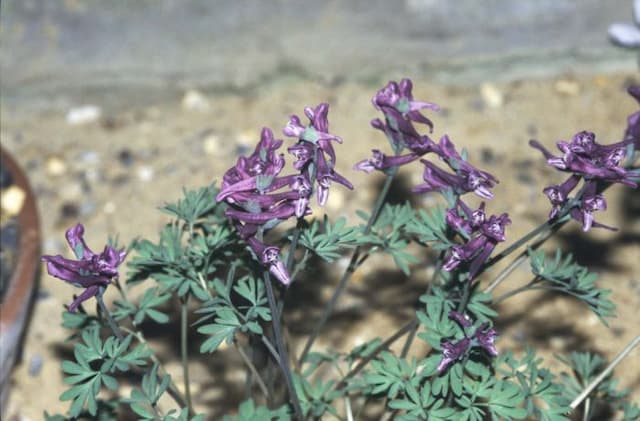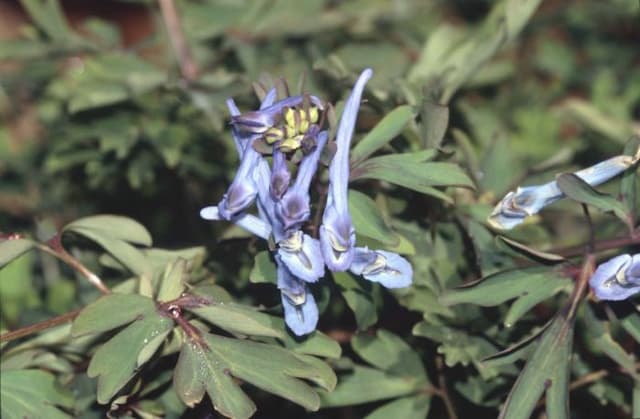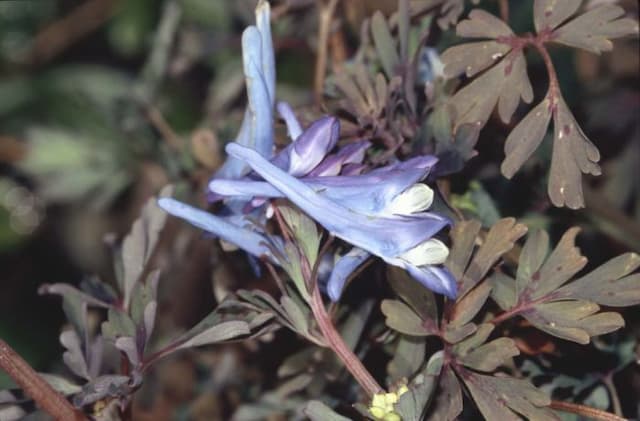Opium poppy 'Black Paeony' Papaver somniferum (Paeoniiflorum Group) 'Black Paeony' (d)

ABOUT
'Black Paeony' is an upright annual, to 90cm tall, with heart-shaped, silvery leaves; the upper ones clasping the stem and with toothed, wavy margins. The fully double flowers have shiny, very dark red-black petals, and are followed by decorative, pepperpot seed pods; good for cutting fresh or dried
About this plant
 Names
NamesFamily
Papaveraceae.
Synonyms
Opium Poppy, Breadseed Poppy, Black Peony Poppy.
Common names
Papaver somniferum.
 Characteristics
CharacteristicsLife cycle
Annuals
Foliage type
Deciduous
Color of leaves
Green
Flower color
Purple
Height
2-3 feet (60-90 cm)
Spread
1-2 feet (30-60 cm)
Plant type
Herb
Hardiness zones
7
Native area
Mediterranean
Benefits
 General Benefits
General Benefits- Aesthetic Appeal: The 'Black Paeony' has large, double flowers with a deep purple to black color that adds a unique visual interest to any garden or landscape.
- Pollinator Attraction: The blooms attract bees and butterflies, which are essential pollinators for many gardens and ecosystems.
- Culinary Use: The seeds of the opium poppy, from which 'Black Paeony' is derived, can be used in baking and cooking, although one must be careful with regulations concerning growing poppies.
- Easy to Grow: It is fairly easy to cultivate in a range of soil types, as long as there is good drainage and sufficient sunlight.
- Drought Resistance: Once established, it can tolerate periods of drought, making it suitable for xeriscaping or gardens in dry climates.
- Self-Seeding Capacity: The plant can self-seed under the right conditions, potentially reducing the need for replanting year after year.
- Cultural Symbolism: Poppies are symbolic flowers with various meanings around the world, often associated with remembrance and peace.
 Medical Properties
Medical Properties- Analgesic: Opium Poppy is known for its derivatives like morphine and codeine, which have strong pain-relieving properties.
- Antitussive: Codeine, extracted from opium poppy, is frequently used to reduce coughing.
- Sedative: The alkaloids found in Opium Poppy have sedative effects that can induce sleep or reduce anxiety.
- Gastrointestinal treatments: Opium Poppy derivatives are sometimes used to treat diarrhea and intestinal spasms due to their antiperistaltic effects.
 Air-purifying Qualities
Air-purifying QualitiesThis plant is not specifically known for air purifying qualities.
 Other Uses
Other Uses- Floral Arrangements: The 'Black Paeony' poppy, with its distinct deep purple to black flowers, can add striking contrasts and a touch of drama to floral arrangements.
- Ink Production: The unique color of the 'Black Paeony' poppy petals can potentially be used to produce a natural dye or ink for art projects.
- Culinary Decoration: The dramatic petals can be crystallized or used fresh to elegantly decorate desserts and pastries.
- Fabric Dye: The petals or seeds can be used as a natural dye for fabrics, yielding unique hues for textile crafts.
- Photography Subject: Due to its unusual color and form, the 'Black Paeony' poppy serves as a captivating subject for photographers and botanical artists.
- Garden Design: Because of their unique appearance, these poppies are sought after for ornamental garden designs that focus on gothic or moody aesthetics.
- Educational Use: The plant can be used as a teaching aid in botany and horticulture courses to explain plant breeding and flower structure.
- Eco Paper Making: The fibers from the stems can be used in the production of handmade, eco-friendly paper.
- Seed Crafts: The seeds of the 'Black Paeony' poppy, while non-narcotic, can be used in crafting, such as jewelry making or incorporated in mosaics.
- Natural Pest Deterrent: Some gardeners plant poppies like the 'Black Paeony' as they are believed to repel certain pests from the garden due to their strong scent.
Interesting Facts
 Feng Shui
Feng ShuiThe Opium Poppy is not used in Feng Shui practice.
 Zodiac Sign Compitability
Zodiac Sign CompitabilityThe Opium Poppy is not used in astrology practice.
 Plant Symbolism
Plant Symbolism- Peace: As a poppy variety, 'Black Paeony' often symbolizes peace due to the flower's association with sleep and oblivion, referencing the ability to escape from reality and find tranquility.
- Death: Poppies are sometimes associated with death, partly because of their use as a symbol to commemorate fallen soldiers, particularly after World War I, and due to their sedative properties which can imply eternal sleep.
- Remembrance: The poppy serves as a symbol of remembrance. This is most prominently seen in countries like the UK, Canada, and Australia, where poppies are worn to remember the sacrifices made by soldiers during war.
- Beauty and success: With their lush, full blooms, 'Black Paeony' poppies represent beauty and success. The dramatic appearance of the dark, peony-like flowers evokes a sense of grandeur and triumph.
- Sleep and rest: Due to the opiate properties extracted from some types of poppies, they symbolize sleep, rest, and recovery. The 'Black Paeony' with its dense petals can invoke a sense of calm, suggestive of a peaceful slumber.
- Resilience: Poppies, despite their delicate appearance, can thrive in difficult conditions, symbolizing resilience and the ability to recover from adversity.
 Water
WaterOpium poppy 'Black Paeony' prefers evenly moist soil, so it’s important to water when the top inch of soil feels dry to the touch. Typically, this may be once or twice a week, depending on the climate and weather conditions. Use a watering can or hose to gently water at the base of the plant to avoid wetting the foliage. As a general guide, providing about 1 gallon of water per week should be adequate for maintaining proper moisture levels. During extremely hot or dry periods, additional watering may be necessary to keep the soil from drying out.
 Light
LightOpium poppy 'Black Paeony' thrives best in full sun conditions, receiving at least 6 hours of direct sunlight daily. A spot that has clear access to the southern or western sun exposure is ideal. Avoid planting in areas that are heavily shaded or receive only partial sunlight, as this can affect bloom quality and plant vigor.
 Temperature
TemperatureOpium poppy 'Black Paeony' can tolerate a wide range of temperatures but grows best in temperatures between 60°F and 70°F. It's crucial to plant after the threat of frost has passed, as it does not tolerate freezing conditions well. The plant can withstand brief exposure to temperatures as low as 28°F but sustained cold may damage or kill it. Ideal growth occurs in an environment where nighttime temperatures do not drop below 50°F.
 Pruning
PruningPruning opium poppy 'Black Paeony' is generally not necessary, as it is an annual plant that completes its lifecycle within a single season. However, deadheading spent flowers can encourage further blooming. After flowering, once seed pods have ripened and been harvested if desired, the entire plant can be removed from the garden as it will not return the following year.
 Cleaning
CleaningAs needed
 Soil
SoilOpium poppy thrives in well-draining, fertile soil with a pH around 6.0 to 7.5. A suitable soil mix can be made with equal parts of loam, compost, and perlite or sand to ensure good drainage and fertility.
 Repotting
RepottingOpium poppy is typically not repotted as it is an annual plant; it completes its life cycle in one season and does not require repotting.
 Humidity & Misting
Humidity & MistingOpium poppy prefers a dry to average humidity level and does not require high humidity. It is well-suited to the typical outdoor humidity levels found in its growing zones.
 Suitable locations
Suitable locationsIndoor
Ensure full sun, well-draining soil, and infrequent watering.
Outdoor
Plant in full sun, well-drained soil; water sparingly.
Hardiness zone
7-10 USDA
 Life cycle
Life cycleThe life of the 'Black Peony' poppy (Papaver somniferum Paeoniiflorum Group) begins with seed germination, typically in the early spring after the last frost when the soil has warmed. The plant then quickly develops a rosette of leaves close to the ground. As it matures, it forms a taller stem that supports large, distinctive peony-like blossoms, ranging from dark purple to black in color, which bloom in late spring to early summer. Following pollination, typically by insects, the petals fall, and the plant develops a seed pod. Once the seed pod ripens and dries, it releases the seeds, which can lead to self-sowing if not collected. During the autumn or after the first killing frost, the annual 'Black Peony' poppy dies, completing its life cycle, relying on its seeds for the next generation of plants.
 Propogation
PropogationPropogation time
Spring
Propogation: The most popular method of propagating Papaver somniferum, commonly known as Opium Poppy or Peony Poppy, is by seed. The ideal time to sow the seeds is in early spring, as soon as the soil can be worked on. Since Opium Poppy seeds require light to germinate, they should be scattered directly on the surface of the soil without covering them. A thin scattering is sufficient, and if the seeds are too densely sown, thinning might be necessary later on. It's important to keep the soil moist until germination, which usually takes 7-30 days depending on the conditions. Once the seedlings are established, they typically require little further care, as Opium Poppies are resilient and can thrive in a range of soil conditions, though they do prefer a sunny spot.









